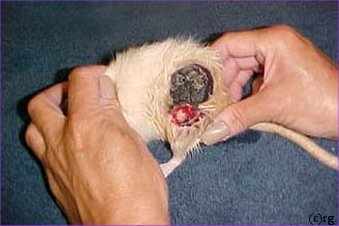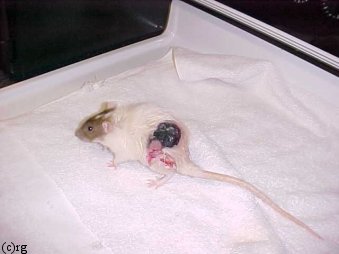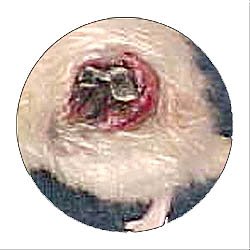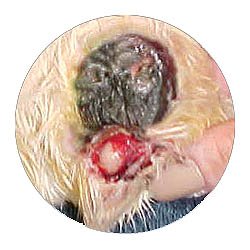Figure 3: Pyoderma and abscessation.
Case history and photos
History
A 18-month-old female rat was brought to a more experienced rat keeper by the owner seeking advice on what appeared to be an abscess near the hip area. At the time, the abscess had been present for approximately six days.
Clinical Signs
When the abscess was lanced the wound was found to be filled with a gross amount of putrid smelling pus. The area was cleansed with Nolvasan, and the rat was taken to a veterinarian.
Initial Treatment
The vet debrided the wound and put the rat on high dosage Clavamox.
Within 12 hours a second abscess had developed right next to the first, and within another 12 hours tissue had become necrotic and bone was completely exposed. By the third day the rat was again brought back to the vet for more aggressive therapy.
Diagnosis
Deep Pyoderma with abscessation.
Possible necrotizing fasciitis (“flesh eating disease”).
Etiology unknown, likely bacterial agent streptococcus spp.
Follow-up Treatment
On the return visit to the vet the third day, Baytril and doxycycline (massive dosages ) were given but no response was seen.
Outcome
The rat developed bacteremia and sepsis and died within several days of the second vet visit. The vet indicated at this time that it was a “flesh eating type” of bacteria. The particular bacteria even ate the tissue so that there was not even a scab on the second abscess, and the hip joint was exposed. The first abscess had a eschar (or a black scab).
Photos
 Photo 1: Shows day 6 of abscess, and the first day treatment begun. |
 Photo 2: Shows day 7 of abscess, and the second day of treatment. |
Photos 3 through 6 show the presence of eschar (pronounced “es kar”), gangrenous, sloughing tissue and advancing tissue destruction by bacteria.
 Photo: 3 |
 Photo: 4 |
 Photo: 5 |
 Photo: 6 |
*Notation: Although no histology was done, the vet supposed it to be a type of streptococcus spp. due to the speed and amount of tissue necrotized.
Case history and photos courtesy of Bellaratta’s Nest Rattery


